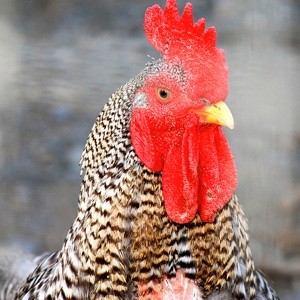 Janelle Sorensen, Healthy Child Healthy World:
Janelle Sorensen, Healthy Child Healthy World:
Unfortunately, this question is not the set up for a joke. It’s a common practice in the United States to disinfect chickens in chlorine baths. According to the new book, Planet Home, by Jeffrey Hollender and Alexandra Zissu:
“One of the many hot-button topics when it comes to chicken – conventional vs. local/pastured vs. free range organic (local or not) – is how the birds are disinfected post-slaughter. Conventional chickens in the United States tend to be disinfected in chlorine baths, a procedure that has long been banned by the European Union. It’s also banned by USDA organic rules.”
Ew.
Now, I know it’s not straight chlorine – it has to be a specific dilution – but, even small levels of chlorine in water can interact with organic matter (like meat) to create dangerous by-products (not to mention the fact that the manufacture of chlorine is awful for the environment and horrible for the workers.)
Why do they do it? To kill pathogens, of course, which pose another laundry list of risks. SimpleSteps.org, a program of the NRDC, tells us:
Illness from contaminated food is a serious public health problem in the U.S. While modern poultry and egg production practices may be lowering prices, they are also increasing the risks of illness from pathogen-tainted eggs and meat. Common symptoms of foodborne illness include diarrhea, abdominal cramping, fever, headache, vomiting, severe exhaustion, and bloody stools; sometimes infections produce more serious, lasting health problems or even death.
Factory farms and industrial slaughterhouses offer distressingly ideal conditions for the development and spread of pathogens. Almost all meat chickens (known as “broilers”) are raised today in factory farms, where they live on the floor of large buildings with twenty to thirty thousand of their sisters. Each bird has only 1/2 to 1 square foot of space — space that often is littered with months or even years of poultry waste, according to the Humane Society of the United States.
More ew.
What’s a concerned consumer to do?
Looking for the USDA Organic label may be the easiest solution, but it’s also much more expensive. For most of us, it’s more practical to get to know where our food comes from.
- Call the manufacturers of the chickens available at your local grocery store and ask what method of post-slaughter disinfection they use. Some major chicken producers use safer methods like electrolyzed water or ozone to disinfect their chickens.
- Find a local farmer, learn about their practices and buy direct from a source you can trust. Use LocalHarvest.org and the Eat Well Guide for help.
- Raise your own. Seriously. The backyard chicken movement is building every year and there are tons of resources to help you get started.
- Raising BackYard Chickens, Build a Chicken Coop, Pictures of Breeds
- Urban Chickens – Dedicated to promoting backyard chickens in urban residential landscapes.
- Chicken Keeping Secrets – How To Keep Chickens at Home
(My family has decided to try this adventurous option – I’ll let you know how it goes. And if you have advice, please let me know!)
One final thought…I was asked to look into whether kosher or halaal foods allowed this practice. An agricultural specialist describes poultry processing here, making note of kosher and halaal requirements, but she doesn’t say anything about different disinfection processes. This leads me to assume chlorinated baths are allowed for kosher and halaal meats. Anyone know differently?
————–
P.S. I strongly recommend you pick up a copy of Planet Home. It’s not only a practical guide to cleaning and greening your home, it’s also an enlightening journey into conscious living. Throughout the book, the authors highlight the big picture of our interconnected human family and ecosystem, as well as provide inspirational tips for slowing down and appreciating life. (Being a very visual person, I also have to mention how awesome the graphics are. They really helped the words make a compelling cognitive impact.)
image courtesy of Sh4rp_i / CC BY-SA 2.0
Leave a Reply